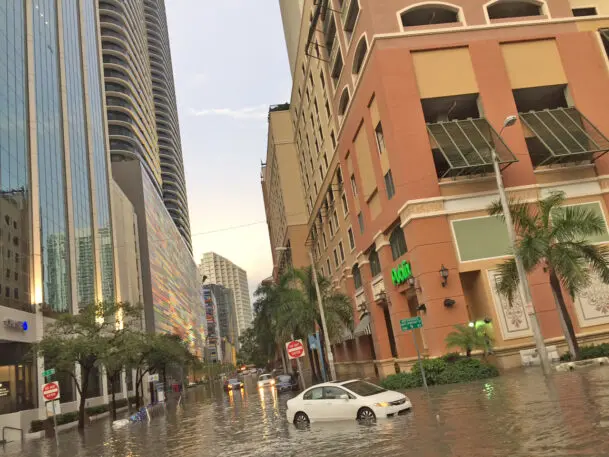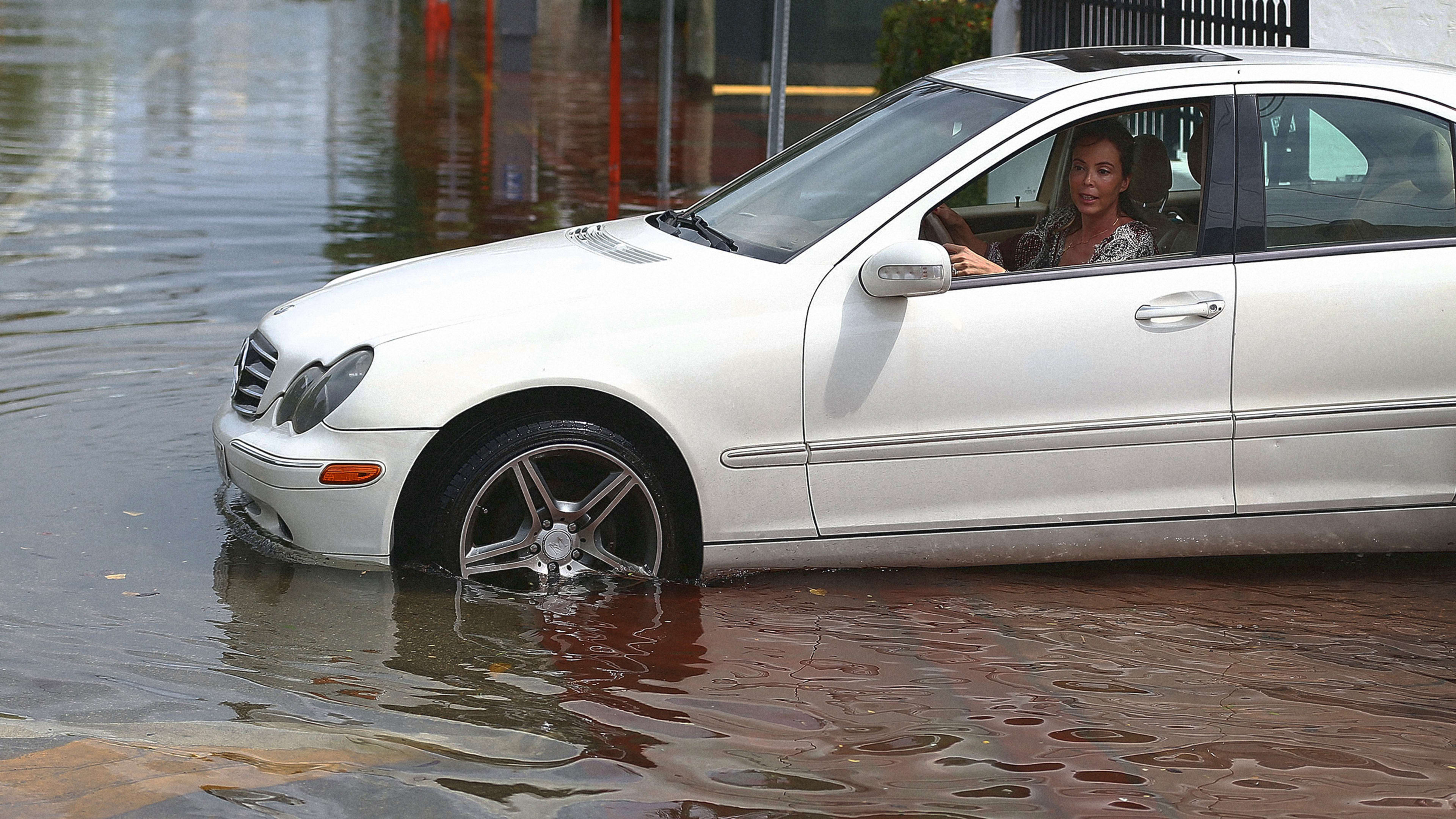Several times a year, the residents of Miami’s Shorecrest neighborhood look out their windows to find that their streets are flooded. Again. The neighborhood sits on Miami’s Biscayne Bay, where sea levels are rising about an inch every few years, and it fills up with water during high tides. The sewage-laden water comes up through the storm drains, filling the streets, and rising up around the tires of residents’ cars, making it impossible to drive. If a tidal flood happens in the morning, commuters are out of luck—they either stay at home, or risk getting stuck in saltwater on their way downtown.
This phenomenon is known as “nuisance flooding,” and it’s becoming more common in coastal cities as sea levels rise. The catastrophic consequences of climate change have become even clearer over the past few years as a succession of billion-dollar disasters have struck the United States. Yet, the commuting disruptions in cities like Miami show how the climate crisis will alter the patterns of everyday life as well. As driving to work gets harder and harder, the rising seas will devalue properties and imperil even those workers who live on high ground. In the absence of near-term infrastructure improvements like roadway elevation and climate-sensitive traffic planning, the flooding will worsen the gap between white-collar and blue-collar workers.
Urban planners in cities like Miami designed the built environment of the waterfront according to their estimates of normal tidal cycles: If the water rises so high on the average day, the planners built streets and bulkheads a little higher. In many cities, though, these estimates are decades out of date: The sea level around Miami has risen about a foot over the past century, which makes a big difference in a city with many neighborhoods that sit just 3 or 4 feet above sea level.

The paper also estimated that commuting disruptions could get worse over the next few decades. Mathew Hauer, a sociology professor at Florida State University and the lead author of the study, found that under the highest sea-level-rise projections, average annual commuting delays would exceed four hours, and more than 55,000 commuters would face an impassable trip.
“It’s not just people who are on [Miami] Beach and trying to commute somewhere,” Hauer says. “You have people commuting into the Beach as well, in which case they experience it, and people commuting through the Beach, who have to go through an area that’s flooding. Their home street might not flood, their work street might not, but in between they encounter flooding.”
This routine flooding has direct consequences not only for commuters’ quality of life, but also for their economic stability. Take, for instance, the gambling hub of Atlantic City. It sits on a shoreline barrier island, but many casino workers commute in from the mainland, driving 3 miles on roadways that are subject to frequent flooding when tides are high. As flood events become more severe, a large section of the gambling industry’s labor force will find itself shut out from work dozens of times a year. For workers who earn an hourly wage, or whose bosses aren’t forgiving about lateness, flooding could spell serious financial trouble.
The situation is similar on the opposite coast in the cities north of San Francisco. According to California State Transportation Agency (CalSTA), sea-level rise by 2050 could entirely inundate state road Route 37, which runs next to San Pablo Bay, severing a vital link between dense East Bay communities like Vallejo and the wine tourism regions of Napa and Sonoma. Already, the road closes about 10 times a year due to flooding. There are no alternate routes around the northern circumference of the Bay. The impact of frequent flooding on this route would be severe for both the workers heading to Napa and Sonoma and the wineries dependent on their labor.
Commuting disruptions can also make existing traffic snarls worse. That’s happening in Miami, affecting even areas without routine residential flooding. “One of our main challenges here is traffic,” says Katherine Hagemann, resilience program manager for Miami-Dade County, who helps coordinate the county’s climate adaptation measures. “We have had a tremendous amount of growth as a city, growth . . . that is very oriented around the car. That growth has definitely led to traffic—that’s just kind of our baseline condition. So when we have tidal flooding, that creates big issues.”
The worst disruptions come during so-called king tides, once or twice a year occurrences when the gravitational forces of the sun and moon combine to create the highest-tide events. Such effects have occurred in cities like Boston, where a king tide in 2019 forced walking commuters to take off their shoes as they waded through downtown puddles; and in Norfolk, Virginia, where a king tide last year filled residential streets and trapped cars in their driveways.
Sunny-day floods of this magnitude are still infrequent, but 10 years from now that might not be the case. The orbital “wobble” of the moon means that some decades see much higher tidal variation than others. The next period of higher-than-average tides will arrive in the mid-2030s, by which point the oceans will have risen another few inches around coastal cities. Research suggests the two trends will compound each other and make large-scale tidal floods even more common, possibly extending the events as long as a month.
The good news is that municipalities like Miami still have time to mitigate the impacts of these floods. The first and most basic solution is to elevate critical roadways, something President Biden’s new infrastructure bill should help fund. These measures aren’t always popular, though, even with people they’re intended to protect, For instance, one group of residents in Miami Beach sued the city for raising roads by as much as 2 feet, claiming that the project pushed flood water into their yards. There’s also the possibility that rapid sea-level rise could require the city to raise roads again in 50 years.
“If we can’t raise roads above the height of adjacent property, we can put in drainage, and try and pump the water off the street faster, but that has limitations too,” says Hagemann. One option detailed in the county’s sea-level rise strategy is to “live with a little bit more flooding”—in other words, she says, to “make sure everything that’s important, like houses and fire stations, remains dry, and tolerate a little flooding” everywhere else. Employers would need to get more flexible about work attendance on flood days, and the city would need to invest in congestion relief on alternative routes, but a little expectation-setting could go a long way toward reducing the number of people who get stuck on waterlogged roads.
Another solution would be to identify and expand alternate routes, giving commuters other options on days when certain roads are impassable. In the case of the Bay Area’s Route 37, for instance, CalSTA has considered expanding bus and rail lines. In the meantime, public communication is paramount: the city of Miami Beach has created an app that alerts commuters when roads are out of service due to flooding. The city of Miami also offers free parking passes to residents in neighborhoods like Shorecrest, allowing them to move their cars at no charge during high tides.
In the absence of significant infrastructure and policy solutions, though, most of the adaptation to sea-level rise will be voluntary, as frustrated commuters either spend more time working from home or relocate to areas with better road access. Hauer says this kind of response will be far more available to high-income earners whose jobs allow for remote work or who can afford to move. In that way, the response will look a lot like the remote-work divide of the early pandemic, wherein white-collar workers stayed home and low-income earners went to work.
But the biggest takeaway, he says, is that climate adaptation is no longer something that can continue to be deferred to the future.
“Oftentimes, we talk about sea-level rise happening way off in 2100,” he says, “and we neglect the fact that these impacts are happening already in a lot of areas. People are already dealing with this.”
This article originally appeared in Grist, a nonprofit, independent media organization dedicated to telling stories of climate solutions and a just future. Sign up for its newsletter here.
Recognize your brand’s excellence by applying to this year’s Brands That Matter Awards before the early-rate deadline, May 3.
